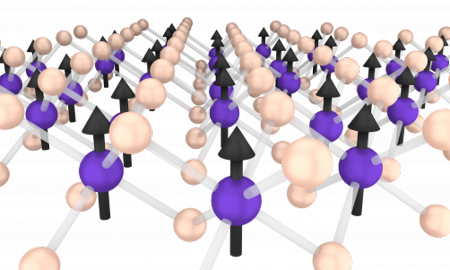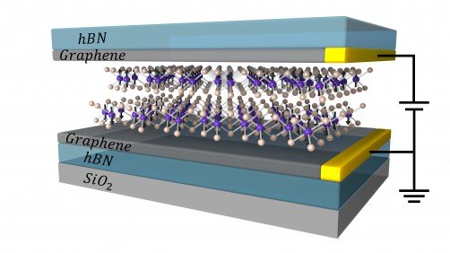R&D: Atomically Thin Magnetic Device Could Lead to New Memory Technologies
Used stacks of ultra-thin materials to exert control over flow of electrons based on direction of spins
This is a Press Release edited by StorageNewsletter.com on May 9, 2018 at 1:27 pmFrom the University of Washington (UW)
Magnetic materials are the backbone of modern digital information technologies, such as hard disk storage.
A depiction of the crystal structure of chromium triiodide (CrI3),
with chromium atoms shown in purple and iodine atoms in yellow.
The black arrows represent the electron ‘spins,’ which are analogous
to tiny bar magnets.
(Credit: Tiancheng Song)
A University of Washington-led team has now taken this one step further by encoding information using magnets that are just a few layers of atoms in thickness. This breakthrough may revolutionize both cloud computing technologies and consumer electronics by enabling data storage at a greater density and improved energy efficiency.
In a study published online May 3 in the journal Science, the researchers report that they used stacks of ultra-thin materials to exert unprecedented control over the flow of electrons based on the direction of their spins – where the electron ‘spins’ are analogous to tiny, subatomic magnets. The materials that they used include sheets of chromium tri-iodide (CrI3), a material described in 2017 as the first ever 2-D magnetic insulator. Four sheets – each only atoms thick – created the thinnest system yet that can block electrons based on their spins while exerting more than 10 times stronger control than other methods.
“Our work reveals the possibility to push information storage based on magnetic technologies to the atomically thin limit,” said Tiancheng Song, co-lead author, doctoral student in physics, UW.
In related research, published April 23 in Nature Nanotechnology, the team found ways to electrically control the magnetic properties of this atomically thin magnet.
“With the explosive growth of information, the challenge is how to increase the density of data storage while reducing operation energy,” said Xiaodong Xu, corresponding author, professor of physics and of materials science and engineering, UW, and faculty researcher, at the UW Clean Energy Institute. “The combination of both works points to the possibility of engineering atomically thin magnetic memory devices with energy consumption orders of magnitude smaller than what is currently achievable.“
The Science paper also looks at how this material could allow for a new type of memory storage that exploits the electron spins in each individual sheet.
The researchers sandwiched two layers of CrI3 between conducting sheets of graphene. They showed that, depending on how the spins are aligned between each of the CrI3 sheets, the electrons can either flow unimpeded between the two graphene sheets or were largely blocked from flowing. These two different configurations could act as the bits – the zeroes and ones of binary code in everyday computing – to encode information.
“The functional units of this type of memory are magnetic tunnel junctions, or MTJ, which are magnetic ‘gates’ that can suppress or let through electrical current depending on how the spins align in the junction,” said Xinghan Cai, co-lead author, postdoctoral researcher in physics, UW. “Such a gate is central to realizing this type of small-scale data storage.”
In the experiment, the researchers sandwiched two atomic layers
of CrI3 between graphene contacts and measured
the electron flow through the CrI3.
(Credit: Tiancheng Song)
With up to four layers of CrI3, the team discovered the potential for ‘multi-bit’ information storage. In two layers of CrI3, the spins between each layer are either aligned in the same direction or opposite directions, leading to two different rates that the electrons can flow through the magnetic gate. But with three and four layers, there are more combinations for spins between each layer, leading to multiple, distinct rates at which the electrons can flow through the magnetic material from one graphene sheet to the other.
“Instead of your computer having just two choices to store a piece of data in, it can have a choice A, B, C, even D and beyond,” said Bevin Huang, co-author, doctoral student in physics, UW. “So not only would storage devices using CrI3 junctions be more efficient, but they would intrinsically store more data.“
The researchers’ materials and approach represent a significant improvement over existing techniques under similar operating conditions using magnesium oxide, which is thicker, less effective at blocking electrons and lacks the option for multi-bit information storage.
“Although our current device requires modest magnetic fields and is only functional at low temperature, infeasible for use in current technologies, the device concept and operational principle are novel and groundbreaking,” said Xu. “We hope that with developed electrical control of magnetism and some ingenuity, these tunnel junctions can operate with reduced or even without the need for a magnetic field at high temperature, which could be a game changer for new memory technology.“
Additional co-authors are Nathan Wilson, Kyle Seyler, Lin Zhu and David Cobden, UW; co-corresponding author Wang Yao and Matisse Wei-Yuan Tu, University of Hong Kong; co-corresponding author Di Xiao and Xiao-Ou Zhang, Carnegie Mellon University; Takashi Taniguchi and Kenji Watanabe, National Institute for Materials Science, Tsukuba, Japan; and Michael McGuire, Oak Ridge National Laboratory,Tennessee. The major funder of the research was the U.S. Department of Energy. Part of work was performed at the Research Training Testbeds at the Clean Energy Institute.















 Subscribe to our free daily newsletter
Subscribe to our free daily newsletter

